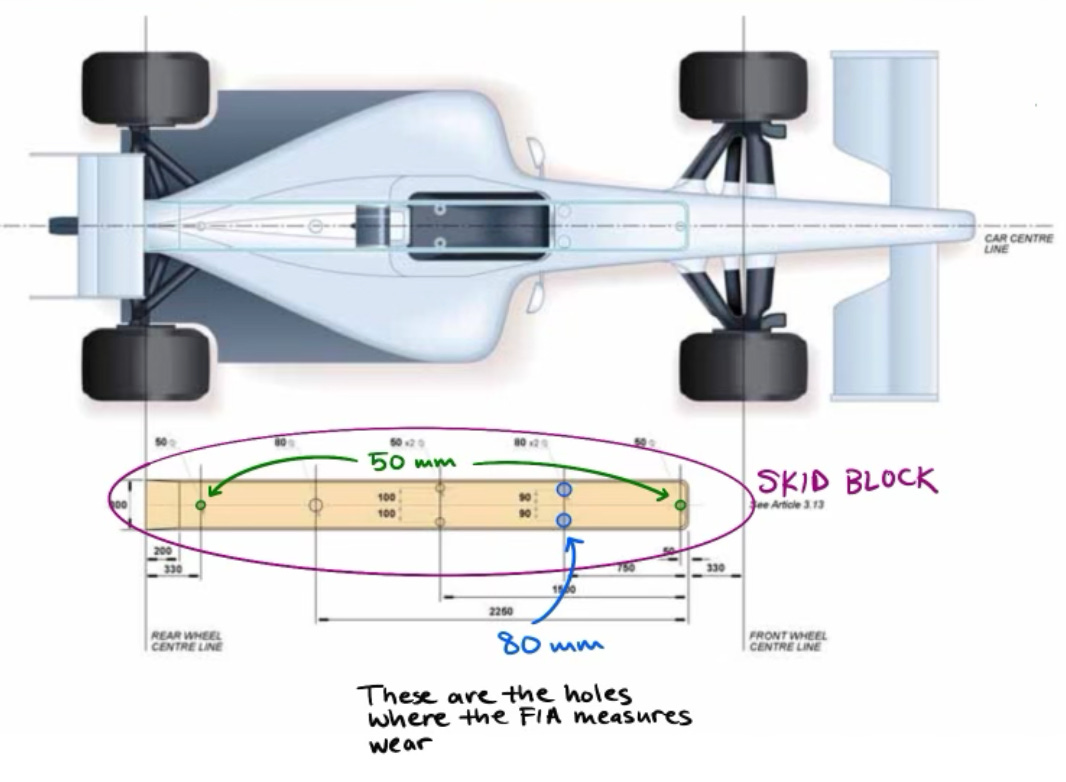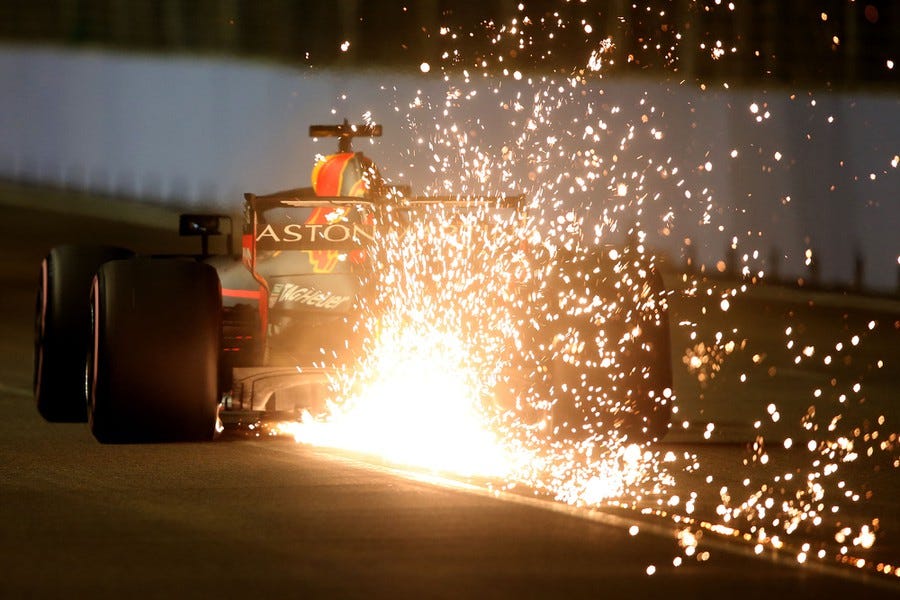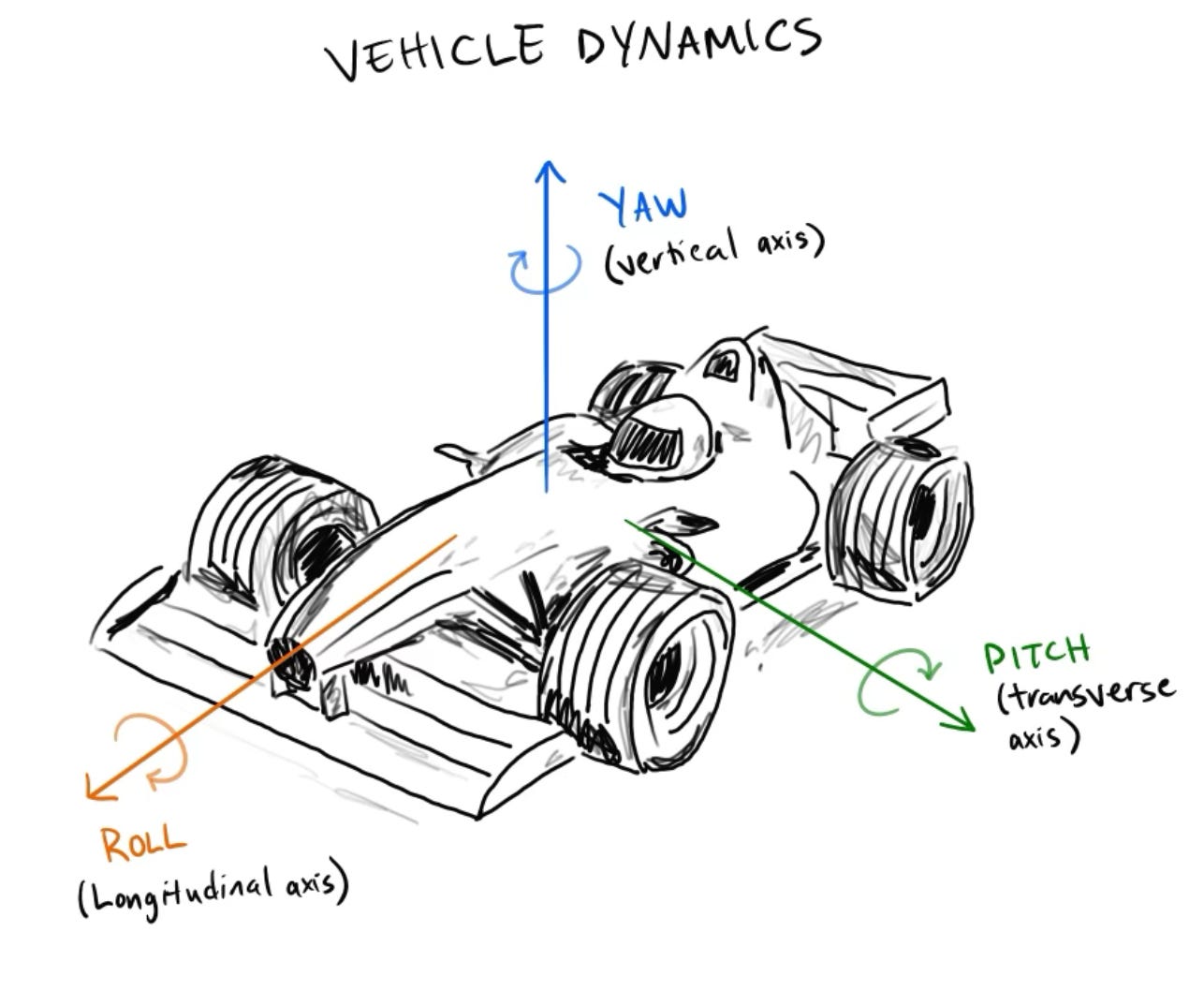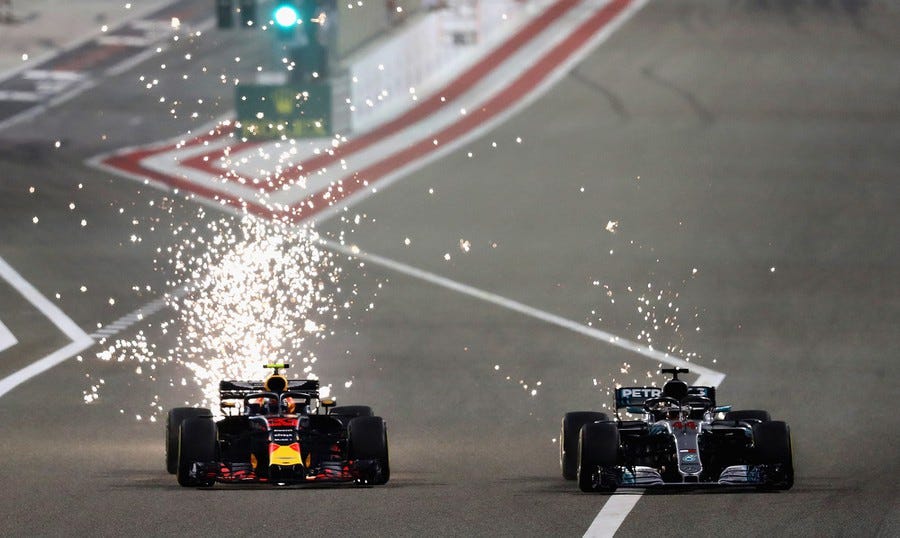Why do Formula 1 cars spark?
Skid Blocks and Vehicle Dynamics
Ever wonder what creates that spectacular shower of sparks at the end of the Formula 1 car?
Vehicle Dynamics
Formula 1 cars run low to the ground with a ride height around 75mm. A stereotypical road car, let’s say a Honda civic, has a ride height of about 6 in or ~150 mm. There is a huge disparity between that and the F1 ride height. That is part of the reason F1 cars are much faster than road cars. A lower ground clearance lowers the center of gravity which helps to decrease vehicle dynamics. Vehicle dynamics include rolling (longitudinal axis), pitching (transverse axis) or yawing (vertical axis). This may happen due to the surface of the track or the driving style.
Decreasing these car motions can make the aerodynamics more efficient and thus increase downforce which also lowers ride height. This can help maximize cornering potential in the car.
Skid Blocks
First mandated in 1994, Formula 1 cars have a skid block underneath the chassis which is used both as a safety measure and to make sure teams don’t run the car too close to the ground to get an extra boost in speed. They are often made of a wooden material called Jabroc but it can be made with any material with a specific gravity (also known as relative density) between 1.3 and 1.45 kg/m^3. The FIA measures the wear on the skid block and if more than 1 mm is worn off at the end of the race, the car will be disqualified.

The infamous 1994 Italian GP was where Ayrton Senna, who is widely known as one of the greatest drivers in the history of Formula 1 racing, died when he ran into an unprotected wall at 130 mph (~210 kph). This is what is generally thought to have prompted the FIA to monitor wear on skid blocks to make sure ground clearance was at a safe height.
The most notable time a car was disqualified for excessive wear was at the 1994 Belgian GP. Nearing the end of the season, Michael Schumacher and Damon Hill were in a close battle for the World Championship. Schumacher crossed the finish line ahead of Hill but was disqualified for wear greater than 1 mm on his skid block and Hill was given 1st place. Schumacher ultimately won the World Championship, but it definitely made for a bigger show.
So, why are the cars sparking?
For many years, teams used a metal brace to secure the skid block and to try to prevent wear on the actual wooden plank. In 2014, titanium was mandated by the FIA to be put on the skid blocks instead of the heavier more resistant metals because it wore down faster. When cars bottom out, or hit the track, sparks fly out. Titanium in particular creates these blinding white sparks due to its lack of iron and high reactivity with oxygen. That is why we see this brilliant spray of sparks coming out the end of F1 cars every race.
Not only do sparks add yet another element of beauty to Formula 1 racing, but they can be used to a drivers advantage. Nigel Mansell, who won the World Championship with Williams in 1992, famously said
“I loved the skid plates, and the sparks. It was such a distraction to anyone following you.”
He would intentionally hit the bumpy parts of the road in order to blind the driver behind him and give him the advantage.
Are sparks dangerous?
Titanium happens to have the safest sparks, and it will not burn drivers helmets or cars. However, these skid blocks can have an impact on the track by making ripples on the surface of the track in big braking zones. This is sometimes called washboarding.
Sources:
https://f1experiences.com/blog/f1-questions-you-always-had-but-were-afraid-to-ask
https://onestopracing.com/watch-this-is-why-f1-cars-spark/#:~:text=Because%20F1%20cars%20are%20so,of%20sparks%20behind%20the%20car.
https://www.liskeforensics.com/blog/title/vehicle-pitch-roll-and-yaw/id/249/
https://sportslumo.com/motorsport/michael-schumacher-gets-disqualified-in-1994-belgian-grand-prix-almost-costs-f1-championship-rewind/
https://us.motorsport.com/f1/news/titanium-skids-for-safety-not-sparks-fia/2806589/
https://motorsports.nbcsports.com/2014/07/15/f1-titanium-skid-blocks-important-for-safety-says-fia/
https://www.theatlantic.com/photo/2018/09/sparks-fly-on-f1-racetracks/571288/
https://f1chronicle.com/formula-1-car-ride-height/
https://www.formulanerds.com/features/the-story-and-conspiracy-surrounding-the-death-of-ayrton-senna-27-years-on/
https://argent.fia.com/web/fia-public.nsf/15A68242E9992FCEC12577F8004A826A/$FILE/1-2011%20TECHNICAL%20REGULATIONS%2010-12-2010.pdf
https://www.istockphoto.com/photos/race-car-sketch
If you want to learn more about skid blocks, take a look at the FIA regulations





I have been wondering about the sparks!